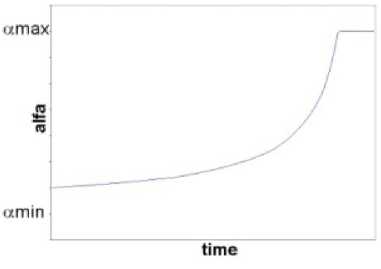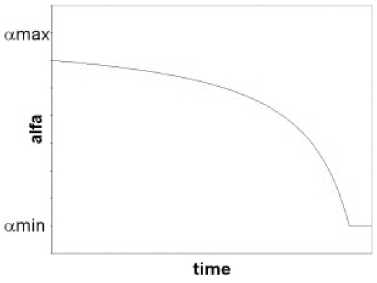The increase in the value of parameter " is determined by expression (13). This increase
can be seen as a hyperbolic divergence from "min, as seen in Figure 12. In expression (13), *
determines the length of the divergence (how much time it will take " to go from "min to
"max), and D determines the speed of the divergence. This smooth modification behaviour
simulates a historic memory of the environment (remembered scenario), so that the value of
" is increased only after several iterations within a certain environment.

Lfinax mother case

(13)

Figure 12. Increase of "i.
The decrease of the parameter " is determined by expression (14). This is similar to the
increase described by expression (13), only that it hyperbolically diverges from "max, as seen
in Figure 13.

ifirrin m other case
> Lfinm

(14)

Figure 13. Decrease of "i.
In Figure 14, we can see an example of the behaviour of the parameter α, as it is
increased, decreased, or remains constant, in dependence of the perceived scenario and the internal
needs. Note that the increase is faster than the decrease, because the values of αi are closer to "max
than they are to "min.
48
More intriguing information
1. Technological progress, organizational change and the size of the Human Resources Department2. Ronald Patterson, Violinist; Brooks Smith, Pianist
3. The name is absent
4. Equity Markets and Economic Development: What Do We Know
5. The name is absent
6. The name is absent
7. The name is absent
8. Solidaristic Wage Bargaining
9. Government spending composition, technical change and wage inequality
10. Artificial neural networks as models of stimulus control*